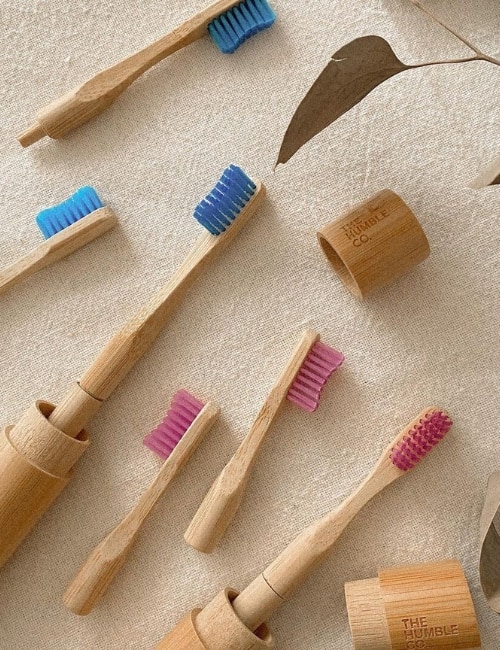The American Dental Association (ADA) recommends brushing your teeth twice a day, in the morning and evening, with a soft-bristled brush.
For optimum dental health, the ADA suggests brushing your teeth for a minimum of 2 minutes each time, and to make sure you brush every tooth.
In addition to brushing, it’s important to also clean between your teeth once a day. You can use dental floss or another interdental cleaner like floss picks or a water flosser.
The Children
As soon as you see an infant’s tooth breaking through, begin brushing it with a soft-bristled infant toothbrush. According to the ADA, you can use a small amount of fluoride toothpaste, about the size of a grain of rice.
Children 3 to 6 years old
can use a pea-size amount of fluoride toothpaste on their toothbrush. You can help them brush their teeth twice a day (morning and night), for 2 inutes each time. since kids are prone to swallowing toothpaste, supervise their brushing sessions until they can spit while brushing.
Tips for brushing your teeth properly
Knowing how to brush your teeth is just as important as how often you brush each day. To help maximize your oral health, follow these tips for brushing your teeth.
Use the proper brushing technique
To brush your teeth, place a soft-bristled brush at a 45-degree angle alongside your gums and move the brush back and forth using short strokes.
Use gentle pressure to avoid hurting or scratching your gums. Brush all sides, including the chewing surfaces of all your teeth. And finally, brush your tongue to remove bacteria.
Use the right type of toothbrush
Using an electric or manual toothbrush is a personal choice.
A 2014 research review showed that an electric toothbrush is more effective at reducing plaque and gingivitis than a standard brush.
But ultimately, it comes down to your dental hygiene habits and what you’re comfortable using
The ADA recommends using a toothbrush that has soft bristles. This type of brush reduces the risk of gum abrasion.
Also, you may want to choose a toothbrush that has multi-level or angled bristles. According to a 2012 research reviewTrusted Source, these toothbrushes perform better at removing plaque than conventional flat-trimmed bristles.
Look for a toothbrush that has the ADA Seal of Acceptance. This indicates that the toothbrush is both safe and effective for removing plaque and reducing your risk of gingivitis.
Replace your toothbrush every 3 to 4 months or sooner if the brush shows excessive wear, such as the bristles fraying.
Floss at least once a day
Cleaning between your teeth at least once a day helps get rid of food and other particles that can get stuck under your gums and between your teeth. The easiest way to accomplish this is with dental floss.
Floss comes in waxed and unwaxed varieties, but according to the ADA, there is no difference in the effectiveness.
Your dentist may also recommend other interdental cleaners like:
floss picks
pre-threaded flossers
powered water flosse
tiny brushes that reach between your teeth
wooden plaque removers
Look for the ADA Seal of Acceptance before purchasing any of these products.
Second: Don’t brush your teeth after eating and drinking these foods
Eating acidic foods and brushing immediately after can weaken the enamel, Dr. Derek Chung says. The same goes for some of your favourite caffeine drinks.
The coffee
Just make sure you’re not rushing to avoid coffee-breath by brushing your teeth immediately after, warns a dental expert.
Dr. Derek Chung, a dentist who is also the founder of Toronto’s Paste Dental office, says that’s because coffee — along with several other foods and beverages — is acidic, and brushing too soon after can wear down the enamel on your teeth.
“The biggest thing that we have to look out for in terms of protecting your enamel is acidity,” Chung said. “Anything that is deemed intuitively as acidic is going to damage your enamel and it’s also going to stain your teeth.”
After eating something acidic, “the enamel actually becomes thinner for a temporary period of time, and it will wear away more quickly,” Chung explained.
“That’s why it’s important not to brush your teeth after having anything acidic — because you will literally be brushing away enamel,” he said.
Don’t brush your teeth right after eating these foods
In a recent TikTok, Chung warned against teeth-brushing immediately after eating pickles or pickled vegetables, eating citrus fruits, drinking coffee, drinking carbonated water, or even vomiting.
The Links
https://www.healthline.com/health/how-many-times-a-day-should-you-brush-your-teeth
https://www.cuimc.columbia.edu/news/brushing-immediately-after-meals-you-may-want-wait
https://www.thestar.com/life/don-t-brush-your-teeth-after-eating-and-drinking-these-foods-expert-warns/article_2e3cf097-8fb8-5ce6-ad8a-8d3e4d3900ad.html







No comments:
Post a Comment